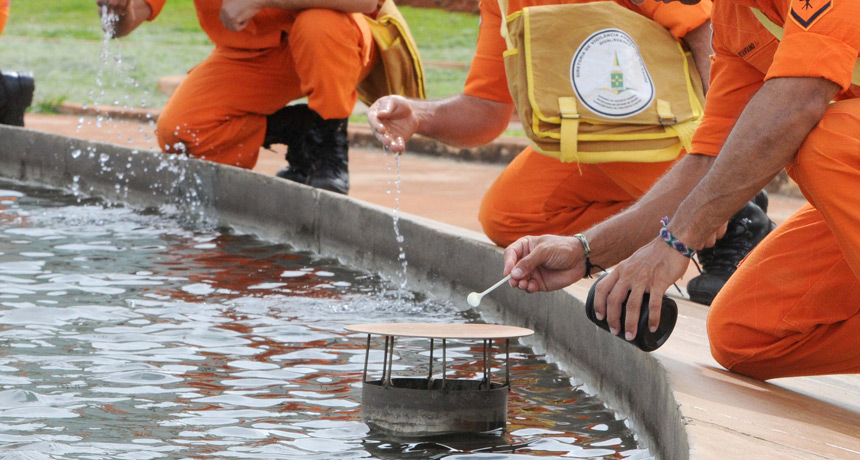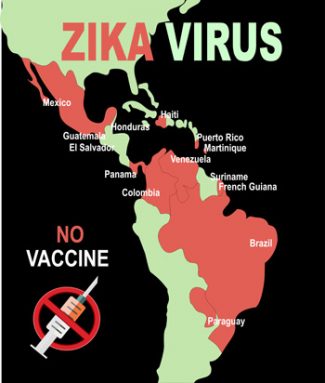End of Latin America’s Zika epidemic is in sight
After this wave of infections ends, the mosquito-borne virus might retreat for decades

Firefighters here in Brasil look for signs of larvae of the mosquito that spreads Zika. The current epidemic there and elsewhere in Latin America may soon die out, a new study finds — and not return for at least 10 years.
Agência Brasília / Flickr (CC BY 2.0)
By Meghan Rosen
The Zika epidemic has battered Latin America since 2015. But within a few short years it should be largely over, a new study suggests.
“If we’re not past the peak already, we’re very close to it,” says Neil Ferguson. He’s from Imperial College London and is one of the study’s authors. After this outbreak winds down, it may be at least a decade before the Zika virus hits the region in a big way again.
Ferguson and his colleagues published their estimate online July 14 in Science.
The new timeline could help researchers get a jump on creating vaccines — drugs that could protect people who have not yet become infected. It also might revise advice to pregnant women trying to avoid Zika-related birth defects. Ferguson’s work suggests something surprising, too. Current efforts to kill Zika-carrying mosquitoes might actually make it easier for the virus to stage a comeback.
The new study is important, says Oliver Pybus. He’s an infectious disease researcher at the University of Oxford in England. “Policy makers would be wise to read it carefully,” he says.
Brazil reported its first cases of Zika in May 2015. Since then, the virus, spread mostly by mosquitoes, has infected people in 48 countries. Scientists have now widely accepted Zika as a cause of a birth defect called microcephaly (My-kro-SEFF-uh-lee). This devastating condition leaves babies with small heads and brains, as well as other serious problems.
Computer simulation suggests epidemic will peter out
Scientists and health officials have hustled to fight Zika. They’ve had trouble keeping up, however. Mosquito-control efforts haven’t helped much, says Ferguson, and a safe vaccine that works could still be years away. What’s more, advising women to postpone pregnancy isn’t always realistic, he says.
Predicting how Zika will spread and for how long could change the way scientists try to quash this epidemic.
Ferguson and his team made a computer model — or simulation — of Zika’s spread within Latin America. (Such a computer program uses mathematical operations to describe how a situation might change over time.) The team used data from 35 countries that have reported Zika cases. The team included many variables. These included how climates vary by season, the ease with which Zika jumps from person to mosquito to person, and patterns of human travel between countries.
Zika has “been burning through the population,” Ferguson says. “Sooner or later, it starts to run out of people to infect,” the model shows.
After the current outbreak ends, some 30 years could pass before Zika surges again, the simulation finds. Once infected with Zika, people are immune to the virus, Ferguson says. That means they can’t be infected again (at least for quite a while). The virus doesn’t need to infect everybody to peter out. It just has to be caught by enough people to prompt what’s known as herd immunity. That term refers to the idea that if most people within a population are immune to a disease, the disease won’t spread. Herd immunity then tends to protect people who are not immune. As a result, an epidemic will eventually die out. And that buys researchers time to develop a treatment before the virus comes back.
Ferguson can’t say for sure that another major Zika outbreak is still three decades away. But he suspects a lull could last at least 10 years.
A down side to fewer infections?
Some countries have tried to curb Zika’s reach by killing the mosquitoes that spread the virus. But this strategy could actually prevent herd immunity, the new simulations suggest. If true, the next epidemic could strike sooner.

That might occur if efforts to kill mosquitoes are only partly effective. In that case, the computer model predicts, a second wave of Zika would hit about five years earlier than if there had been no mosquito control at all.
Mikkel Quam is an epidemiologist — a scientist who studies how diseases spread — at Umeå University in Sweden. He notes that generating herd immunity first requires lots more infections. And that might mean more babies born with birth defects. So, Quam says, “any way to reduce infection is worth doing now, even if it means potentially more epidemics in years to come.”
Immunity to Zika also could pose problems for those working on a vaccine, Ferguson says. By the time a new drug is safe to use, it may be hard to find unexposed people on which to test it.
Still, Ferguson says it’s a chance to think creatively. In the future, researchers could plan ahead and send doctors — stocked with vaccines — early to sites in places where Zika is likely to strike. That way, when (and if) the virus hits, they’re ready to go.
He also thinks his findings could help health officials more clearly lay out the risks to pregnant women. That’s because individual outbreaks within Latin America can taper off after three to six months — sooner than the epidemic as a whole.
By offering different advice in different places, officials might limit the time they may feel a need to advise women to delay any pregnancies.







